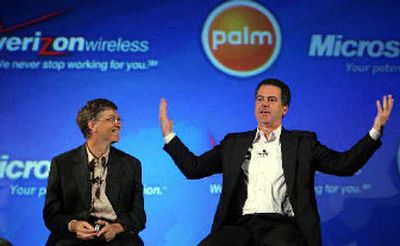Palm allies itself with Microsoft

SAN FRANCISCO — Palm Inc.’s decision to use Windows software in its latest Treo smartphone is a victory for Microsoft Corp. and a setback for the company Palm spun off to develop and sell its original operating system.
In announcing the Treo phone on Monday, Palm CEO Ed Colligan said the Microsoft Windows Mobile 5.0 operating system was chosen because it offered features that PalmOS could not.
“It’s about growth and about taking this whole category to the next level,” he said. “We think that this operating system offers some functionality that the Palm operating system doesn’t necessarily have. Certainly it does some things better.”
Colligan stood beside a former rival, Microsoft Chairman Bill Gates, and Verizon Wireless Chief Executive Denny Strigl as he made the announcement in San Francisco.
Under the alliance, Palm has licensed the Windows Mobile operating system for a new line of smartphones. The first is scheduled to be launched early next year.
Colligan said the PalmOS will remain part of Palm’s future, but industry insiders say that a successful Palm-Microsoft partnership could mean that PalmSource will lose its most significant and oldest customer.
“Palm has been stuck with this ancient operating system,” said Todd Kort, principle analyst with Gartner. “They had no choice but to modernize.”
Maureen O’Connell, a PalmSource spokeswoman declined to discuss specifics how the Microsoft-Palm partnership would mean to PalmSource or PalmOS.
“Palm remains a great customer of ours,” she said.
For more than year, analysts have expected Palm to team up with Microsoft and effectively snub PalmSource. The two were once part of the same company until management decided in 2003 to break them up so the software division could sell PalmOS to other handheld makers.
After the split, Palm agreed to pay PalmSource — which is now being bought by Japanese software company Access Co. for $324 million — a licensing fee for the PalmOS and became its marquee client.
There were also missteps, not the least of which was acquiring Be Inc. in 2001.
PalmSource wanted the Be operating system to help it provide multimedia applications to compete with those offered by Microsoft. But PalmSource’s product, called Cobalt, took two years to develop and upon its rollout has been largely ignored by the major handheld makers.
“It fell on its face,” Kort said. “Buying Be has taken them down the path to destruction.”
Cobalt has been overshadowed by Windows Mobile, say analysts.
Ross Rubin, Director of industry analysis at NPD Group says the Windows Mobile platform offers better support for such things as video and photos. It also offers superior call management.
“These are features that PalmSource promised with Cobalt,” Rubin said. “One of the criticisms levied at PalmOS is that it isn’t great for managing voice applications. Microsoft treats voice as a first class citizen.”
One of Windows Mobile’s most attractive offerings is the ability to run multiple applications, say analysts.
What this has meant is that Microsoft has steadily seized market share away from PalmSource.
In 2000, Microsoft owned only about 11 percent of the handheld market. But just four years later, the Redmond, Wash.-based company had overtaken PalmSource, according to Gartner. In the second quarter this year, about 56 million smartphones equipped with Windows were shipped. Phones featuring PalmOS numbered 48 million.